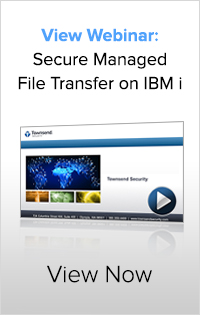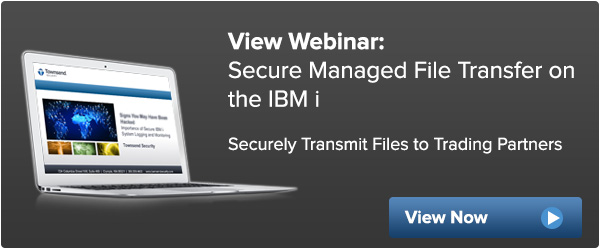The File Transfer Protocol (FTP) has been with us since the dawn of the Internet. Amazingly it is still a critical component of electronic commerce and all large organizations use FTP for integration with their customers and vendors. As a critical part of your electronic commerce infrastructure you want to make sure that your FTP solution is reliable, secure, automated, and manageable. That’s where Managed FTP solutions come into play. Our Alliance FTP Manager falls into this category and helps IBM i (AS/400, iSeries) customers meet this critical need.
 In this blog I want to look at just the security components of a Managed FTP solution. In a future blog we’ll look at the management components in more detail. But let’s start with security!
In this blog I want to look at just the security components of a Managed FTP solution. In a future blog we’ll look at the management components in more detail. But let’s start with security!
Secure Transfer Methods
Of course, we need to be sure that we are securing all of our FTP operations with strong encryption. Older FTP protocols did not encrypt FTP sessions and left organizations exposed to data loss both inside and outside of the corporate network. All of that is changed now. There are two types of secure, encrypted FTP methods in wide use:
-
Secure Sockets Layer FTP (SSL FTP, or sometimes FTPS)
-
Secure Shell FTP (SFTP)
SSL FTP is an extension of the original FTP protocol and is an Internet standard. As the need for secure eCommerce increased in the early 2000s the SSL FTP transfer method gained traction and large organizations transitioned to this secure and encrypted transfer method. Unfortunately, SSL FTP was difficult to implement in typical corporate networks and required modifications to firewall configurations. The complexity of the SSL FTP method made it difficult and expensive to implement and manage.
Secure Shell FTP, or SFTP, is a part of the Unix and Linux Secure Shell set of applications. While originally a Unix application, Secure Shell is now available on a wide set of operating systems and platforms. SFTP provides a secure implementation of file transfer and is much more friendly to the corporate network and network administrators. For this reason most organizations have transitioned to SFTP for their secure and encrypted file transfer needs.
While other open and proprietary solutions exist to transfer files, SSL FTP and SFTP remain the dominant methods of secure file transfer for ecommerce.
Additional Security Requirements
In addition to secure and encrypted transfer of files, a good managed FTP solution provides additional security controls. Let’s take a look at the ones you should find in a managed FTP solution:
File encryption: Many people are surprised to learn that encrypting a file transfer session is not an adequate level of security. When a file arrives at its destination it should also be protected at rest. This means encrypting the file before it is transferred with SFTP or SSL FTP. But doesn’t this mean the data is doubly encrypted? Yes it does. But protecting the file after it is transferred is crucial to a security strategy. Most organizations use Pretty Good Privacy (PGP) to encrypt a file before transfer, and to decrypt files that are received. Your Managed FTP solution should natively integrate PGP encryption into file transfers.
Configuration access control: Configuring managed FTP transfers involves setting local and remote configuration parameters, encryption parameters, and many other aspects of file transfer operation. Your managed FTP solution should implement configuration access controls and notify you of an attempted violation.
Two Factor Authentication (2FA): Control over the administrative functions of a Managed FTP solution should include Two Factor Authentication. This is now a requirement for administrative access to payment card systems by the PCI Data Security Standard (PCI-DSS), but is also a security best practice for any critical system. Be sure your Managed FTP solution provides for 2FA or that you implement 2FA on the IBM i system level.
Compliance audit: Sending and receiving files that contain sensitive data requires that you retain a clear file transfer history. This is a minimal level of audit reporting and you will want to be sure your Managed FTP solution provides clear and easy to read audit trails.
System logging: Actively monitoring your system is a critical security control. On the IBM i server it means monitoring security events and transferring them in real time to a log collection server, or better yet, to a SIEM solution. FTP is often the mechanism by which cyber criminals steal information from your system, so a Managed FTP solution should be logging file transfers to the IBM security audit journal QAUDJRN. The security audit journal provides an un-modifiable repository of security events, and your file transfer information should be recorded there. Look for this feature in your Managed FTP solution.
Software updates and patching: Secure FTP protocols are periodically subject to the need for security patching. A recent security flaw in the SFTP protocol required updates for all systems that implement this Secure Shell protocol. Fortunately, on the IBM i platform IBM provides the SSH implementation as a no-charge licensed product, and updates are available through normal system patching procedures. Be sure that your Managed FTP solution integrates with the IBM solution, or that the Managed FTP vendor has an adequate strategy to provide you with security updates.
Backup and Recovery: As the new EU General Data Protection Regulation (EU GDPR) correctly points out, backup and recovery is a part of your security strategy. If you can’t recover from a system failure in a reasonable period of time you risk losing data that is critical for your customers and employees. We hold that data in trust for them, and protecting it also means resiliency in the event of system failures. Be sure your Managed FTP solution fits into your backup and recovery strategy for the IBM i platform.
These are critical security components of a Managed FTP solution. Some organizations we work with transfer thousands of files every day. I believe we’ve addressed the core security requirements in our own Alliance FTP Manager solution and we continue to invest in R&D to make these features better going forward. I will address other aspects of Managed FTP in future blogs.
Patrick

